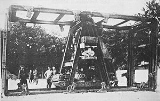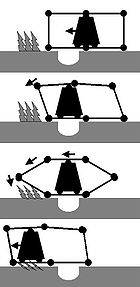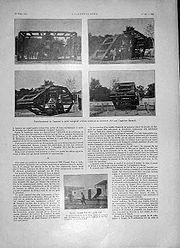
Boirault machine
Encyclopedia
The Boirault machine was an early French experimental landship, designed in 1914 and built in early 1915. It has been considered as "another interesting ancestor of the tank",
and described as a "rhomboid
-shaped skeleton tank without armour, with single overhead track". Ultimately, the machine was deemed impractical and was nicknamed Diplodocus
militaris. It preceded the design and development of the English Little Willie
tank by six months.
characterizing the First World War led to a need for a powerfully armed military engine that would be at the same protected from enemy fire and could move on the extremely irregular terrain of battlefields.
As early as 24 August 1914, the French colonel Jean-Baptiste Estienne articulated the vision of a cross-country armoured vehicle:

 One of the first attempts was made in France with the early experiment made with the Boirault machine, developed in 1914 by French engineer Louis Boirault, proposed to the French War Ministry in December 1914, and ordered for construction on 3 January 1915. On 19 January a commission, headed by Sub-secretary of State of Inventions Paul Painlevé
One of the first attempts was made in France with the early experiment made with the Boirault machine, developed in 1914 by French engineer Louis Boirault, proposed to the French War Ministry in December 1914, and ordered for construction on 3 January 1915. On 19 January a commission, headed by Sub-secretary of State of Inventions Paul Painlevé
, was formed to evaluate the project.
The objective of the machine was flattening barbed wire
defences and riding over gaps in a battlefield. The machine was made of huge parallel tracks, formed by six 4x3 meter metallic frames, each with four transverse beams, so that it could also be described as a single track covering the entire width of the vehicle, rotating around a triangular motorized center, and driven via chains and rods by a 80 hp petrol engine.
This device proved too fragile and slow however, as well as incapable of changing direction easily, as was indicated be a report on 17 May. The project was officially abandoned on 10 June 1915. Upon the insistence of the inventor, modifications were made, a new commission was formed and new trials organized on 4 November 1915, for the benefit of the Engineer Arm. The machine, loaded with nine tonnes of simulation weights, successfully flattened an eight metre wide barbed wire obstacle, overcame a funnel with a diameter of five metres and crossed a trench two metres wide. It reached a speed of 1,6 km/h. A second test on 13 November showed however that is was still extremely difficult to change direction. The whole assembly had to be lifted by a main jack, after which it could be turned for a maximum of 45° by hand from the outside or by a system of smaller jacks from the inside of the machine. Again the project was rejected, because of its visibility, noise, vulnerability, low speed and lack of manoeuvrability. Military historian Lieutenant-Colonel André Duvignac concluded that those that had baptised it Diplodocus militaris (after a giant sauropod
dinosaur
, well-known at the period) "were not only poor humorists but also good judges".
, until complete abandonment of the project.
General Henri Gouraud commented on the performance of the machine on 20 August 1916, explaining that it ran for 1,500 meters in flat terrain, at about 1 km/h. It managed to cross a railroad, flatten a line of barbed wire
, and crossed trenches 1.5 and 1.8 meters wide, and a hole two meters in diameter.
General Gouraud commented on the sheer strength of the machine, but its weak ability to properly direct itself:
had already sent out its chief designer, Eugène Brillié, to investigate tracked tractors from the American Holt Company, at that time participating in a test programme in England
. This Schneider program was met with approbation of the French War Ministry, was merged with the Estienne plan, and a production order of 400 Schneider CA1
, the first French tank to see the battlefield, was made on 25 February 1916.
and described as a "rhomboid
Rhomboid
Traditionally, in two-dimensional geometry, a rhomboid is a parallelogram in which adjacent sides are of unequal lengths and angles are oblique.A parallelogram with sides of equal length is a rhombus but not a rhomboid....
-shaped skeleton tank without armour, with single overhead track". Ultimately, the machine was deemed impractical and was nicknamed Diplodocus
Diplodocus
Diplodocus , or )is a genus of diplodocid sauropod dinosaur whose fossils were first discovered in 1877 by S. W. Williston. The generic name, coined by Othniel Charles Marsh in 1878, is a Neo-Latin term derived from Greek "double" and "beam", in reference to its double-beamed chevron bones...
militaris. It preceded the design and development of the English Little Willie
Little Willie
Little Willie was a prototype in the development of the British Mark I tank. Constructed in the summer of 1915 through a close cooperation of the military and industry of the United Kingdom, it was the first completed tank prototype in history...
tank by six months.
Background
The immobility of the trench warfareTrench warfare
Trench warfare is a form of occupied fighting lines, consisting largely of trenches, in which troops are largely immune to the enemy's small arms fire and are substantially sheltered from artillery...
characterizing the First World War led to a need for a powerfully armed military engine that would be at the same protected from enemy fire and could move on the extremely irregular terrain of battlefields.
As early as 24 August 1914, the French colonel Jean-Baptiste Estienne articulated the vision of a cross-country armoured vehicle:
First Boirault machine


Paul Painlevé
Paul Painlevé was a French mathematician and politician. He served twice as Prime Minister of the Third Republic: 12 September – 13 November 1917 and 17 April – 22 November 1925.-Early life:Painlevé was born in Paris....
, was formed to evaluate the project.
The objective of the machine was flattening barbed wire
Barbed wire
Barbed wire, also known as barb wire , is a type of fencing wire constructed with sharp edges or points arranged at intervals along the strand. It is used to construct inexpensive fences and is used atop walls surrounding secured property...
defences and riding over gaps in a battlefield. The machine was made of huge parallel tracks, formed by six 4x3 meter metallic frames, each with four transverse beams, so that it could also be described as a single track covering the entire width of the vehicle, rotating around a triangular motorized center, and driven via chains and rods by a 80 hp petrol engine.
This device proved too fragile and slow however, as well as incapable of changing direction easily, as was indicated be a report on 17 May. The project was officially abandoned on 10 June 1915. Upon the insistence of the inventor, modifications were made, a new commission was formed and new trials organized on 4 November 1915, for the benefit of the Engineer Arm. The machine, loaded with nine tonnes of simulation weights, successfully flattened an eight metre wide barbed wire obstacle, overcame a funnel with a diameter of five metres and crossed a trench two metres wide. It reached a speed of 1,6 km/h. A second test on 13 November showed however that is was still extremely difficult to change direction. The whole assembly had to be lifted by a main jack, after which it could be turned for a maximum of 45° by hand from the outside or by a system of smaller jacks from the inside of the machine. Again the project was rejected, because of its visibility, noise, vulnerability, low speed and lack of manoeuvrability. Military historian Lieutenant-Colonel André Duvignac concluded that those that had baptised it Diplodocus militaris (after a giant sauropod
Sauropoda
Sauropoda , or the sauropods , are an infraorder of saurischian dinosaurs. They had long necks, long tails, small heads , and thick, pillar-like legs. They are notable for the enormous sizes attained by some species, and the group includes the largest animals to have ever lived on land...
dinosaur
Dinosaur
Dinosaurs are a diverse group of animals of the clade and superorder Dinosauria. They were the dominant terrestrial vertebrates for over 160 million years, from the late Triassic period until the end of the Cretaceous , when the Cretaceous–Paleogene extinction event led to the extinction of...
, well-known at the period) "were not only poor humorists but also good judges".
Second Boirault machine
A new model was developed, more compact and lighter, with armour for the engine and the driver compartment. It was composed of six metal plates rotating around the core chassis, and had some level of steering control, allowing for a turning radius of 100 meters. Speed however was extremely low, at 1 km/h. The new model was tried by the Artillery Arm on 17 August 1916 at Souain-Perthes-lès-HurlusSouain-Perthes-lès-Hurlus
Souain-Perthes-lès-Hurlus is a commune in the Marne department in north-eastern France.On 9 December 1915 at Souain, a former battlefield with rough terrain and trenches, and in the presence of General Philippe Pétain, a prototype armoured vehicle motorized with a Baby Holt caterpillar was...
, until complete abandonment of the project.
General Henri Gouraud commented on the performance of the machine on 20 August 1916, explaining that it ran for 1,500 meters in flat terrain, at about 1 km/h. It managed to cross a railroad, flatten a line of barbed wire
Barbed wire
Barbed wire, also known as barb wire , is a type of fencing wire constructed with sharp edges or points arranged at intervals along the strand. It is used to construct inexpensive fences and is used atop walls surrounding secured property...
, and crossed trenches 1.5 and 1.8 meters wide, and a hole two meters in diameter.
General Gouraud commented on the sheer strength of the machine, but its weak ability to properly direct itself:
Aftermath
The project was actually abandoned as regular tanks were being developed. A few months before, in January 1915, the French arms manufacturer Schneider & Co.Schneider Electric
Schneider Electric is a French global company. It was founded in 1836 by two brothers, Eugène and Adolphe Schneider.In the first part of the 20th century, Schneider et Cie associated itself with Westinghouse Systems, a major international electrical group at the time. The group began manufacturing...
had already sent out its chief designer, Eugène Brillié, to investigate tracked tractors from the American Holt Company, at that time participating in a test programme in England
England
England is a country that is part of the United Kingdom. It shares land borders with Scotland to the north and Wales to the west; the Irish Sea is to the north west, the Celtic Sea to the south west, with the North Sea to the east and the English Channel to the south separating it from continental...
. This Schneider program was met with approbation of the French War Ministry, was merged with the Estienne plan, and a production order of 400 Schneider CA1
Schneider CA1
The Schneider CA1 was the first French tank. It was inspired by the need to overcome the stalemate of the trench warfare of the Great War.-Caterpillar development:...
, the first French tank to see the battlefield, was made on 25 February 1916.

